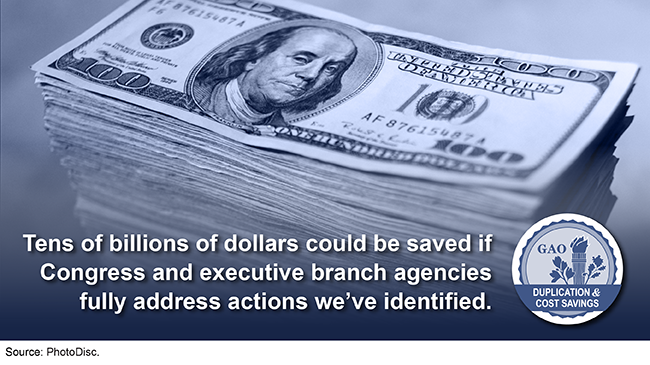Addressing Fragmentation, Overlap, and Duplication: Progress in Enhancing Government Effectiveness and Achieving Hundreds of Billions of Dollars in Financial Benefits
Fast Facts
We have issued 11 annual reports on federal programs with fragmented, overlapping, or duplicative goals or activities. In those reports, we suggested hundreds of ways to address those problems, reduce costs, or boost revenue. Our most recent report is from May 2021.
Since these annual reports began, Congress and agencies have fully or partially implemented many of the actions we suggested. We estimate that this will likely lead to more than half a trillion dollars ($515 billion) in cost savings and revenue increases.
Fully addressing the remaining 441 actions could save tens of billions more dollars and improve government services.

Highlights
What GAO Found
Congress and executive branch agencies have made significant progress in addressing many of the 1,200 actions that GAO identified from 2011 to 2021 to reduce costs, increase revenues, and improve agencies’ operating effectiveness, although work remains to fully address them. As shown in the figure below, these efforts have resulted in approximately $515 billion in financial benefits, an increase of $85 billion from GAO’s 2020 annual report. These are rough estimates based on a variety of sources that considered different time periods and used different data sources, assumptions, and methodologies.
Total Reported Financial Benefits of $515 Billion, as of 2021

To achieve these benefits, as of August 2021, Congress and executive branch agencies have fully addressed 666 (56 percent) of the 1,200 actions GAO identified from 2011 to 2021 and partially addressed 207 (17 percent). Examples of actions taken that led to significant financial benefits include:
- Congress increased the passenger security fee from a prior boarding payment structure to a flat fee, resulting in increased revenues of about $12.9 billion over a 10-year period beginning in 2014 through 2023.
- The Department of Health and Human Services changed its spending limit determinations for Medicaid demonstrations, resulting in federal savings of approximately $120.8 billion from 2016 through 2020, with tens of billions of additional savings to potentially accrue in the future.
Further steps are needed to fully address the actions GAO identified from 2011 to 2021. While GAO is no longer tracking 93 actions due to changing circumstances, GAO estimates that fully addressing the remaining 441 open actions could result in savings of tens of billions of dollars and improved government services, among other benefits. For example:
- The Department of Energy may be able to reduce certain risks by adopting alternative approaches to treating a portion of its low-activity radioactive waste, saving tens of billions of dollars.
- Enhanced Internal Revenue Service enforcement and service capabilities can help reduce the gap between taxes owed and paid by collecting billions in tax revenue and facilitating voluntary compliance.
- The Department of Veterans Affairs could manage fragmentation and improve access to long-term care for veterans by implementing a more consistent approach to this care.
Why GAO Did This Study
The federal government continues to respond to and recover from significant public health and economic challenges battling the COVID-19 pandemic.
While the size and scope of these efforts demand strong accountability and continued agility, opportunities also exist for achieving billions of dollars in financial savings and improving the efficiency and effectiveness of a wide range of federal programs in other areas.
GAO has responded with annual reports to a statutory provision directing it to identify and report on federal programs, agencies, offices, and initiatives—either within departments or government-wide. These entities and initiatives have duplicative, overlapping, or fragmented goals or activities, as well as additional opportunities to achieve cost savings or enhance revenue collection.
This report discusses the progress Congress and executive branch agencies have made in addressing actions GAO identified in its 2011 to 2021 reports. Additionally, the report provides examples of open actions where further steps by Congress and executive branch agencies could yield significant financial and non-financial benefits.
For more information, contact Jessica Lucas-Judy at (202)512-6806 or lucasjudyj@gao.gov, or Michelle Sager at (202)512-6806 or sagerm@gao.gov..
